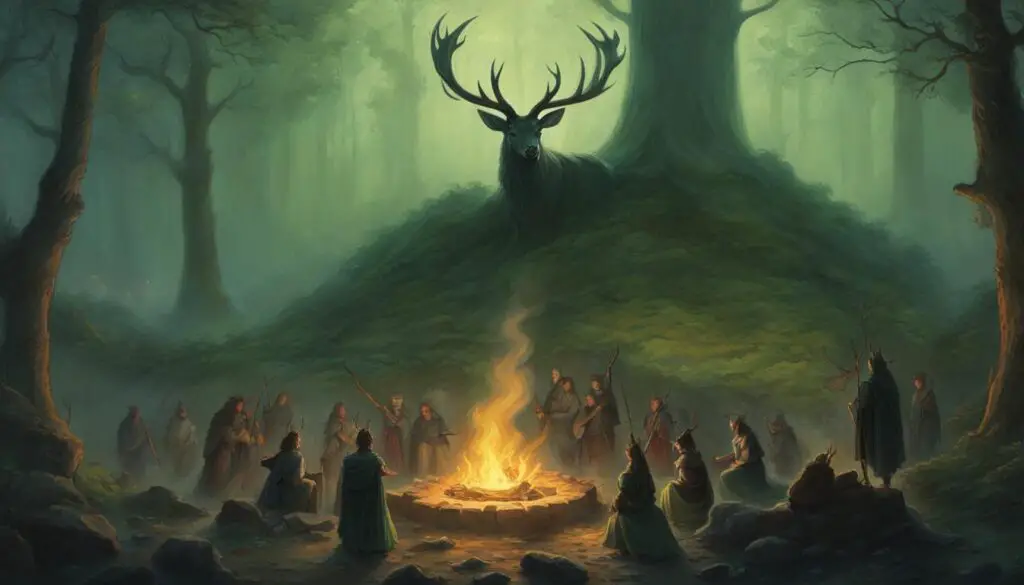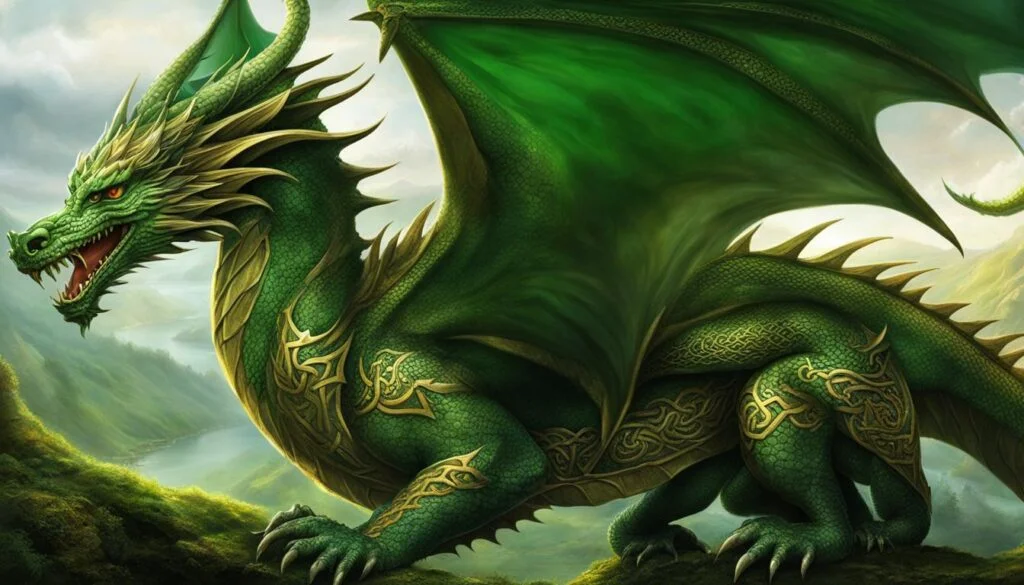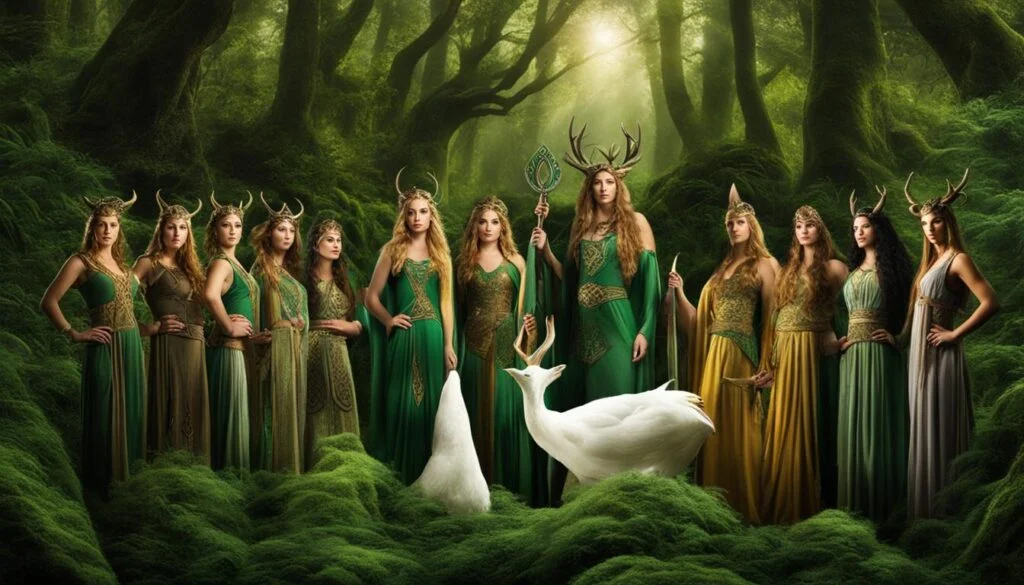Celtic Shamanism is an ancient and profound spiritual practice that originated between 800 BCE and 400 CE in regions like Ireland, Scotland, Wales, and Gaul.
In this article, we will delve into the core principles of Celtic Shamanism and how they were practiced by ancient shamans, often called druids.
Celtic Shamanism is based on the belief in the interconnectedness of the material and spiritual realms. Practitioners saw themselves as caretakers of the natural world, and their practices revolved around maintaining harmony and balance between humans and nature.
With a deep reverence for the land, ancestors, and the Otherworld, Celtic shamans developed rituals and techniques to access spiritual insights, healing, and guidance.
Please join us as we uncover the mysteries of Celtic Shamanism and gain insights into the wisdom of the ancients.
Key Takeaways:
- Celtic Shamanism is an ancient spiritual practice that originated in Celtic regions between 800 BCE and 400 CE.
- Core principles of Celtic Shamanism include a strong connection to nature, reverence for ancestors, belief in the Otherworld, and the importance of sacred sites.
- Rituals and practices of Celtic Shamans include drumming, chanting, herbalism, divination, and connecting with spirit animals.
- By exploring Celtic Shamanism, individuals can deepen their spiritual connections and tap into transformative experiences.
Connection to Nature
Central to Celtic Shamanism is the belief in the intimate connection with the natural world.
Practitioners view nature as a manifestation of the divine and believe that by aligning oneself with its rhythms, one can access spiritual insights and healing.
The Celtic shamans saw nature as a source of wisdom and guidance, and they sought to live in harmony with it.
They recognized that every tree, animal, and element held unique energy and teachings.
By observing and communing with nature, Celtic shamans gained a deeper understanding of the interconnectedness of all living beings.
Through their deep connection to the natural world, Celtic shamans found spiritual insights and healing.
They believed that the Earth itself possessed a profound wisdom that could guide and nurture individuals on their spiritual journey.
The Wisdom of the Trees
- Birch: Symbolizes new beginnings and purification.
- Oak: Represents strength, wisdom, and protection.
- Willow: Signifies intuition, healing, and emotional balance.
- Yew: Associated with death and rebirth, and serves as a gateway to the Otherworld.
Celtic shamans recognized the unique qualities and teachings of each tree, incorporating their energy into their spiritual practices.
They believed that by attuning to the wisdom of the trees, they could tap into the abundant healing energy of nature.
The Power of Animal Allies
- Wolf: Symbolizes loyalty, intuition, and guardianship.
- Raven: Represents magic, transformation, and communication with the Otherworld.
- Deer: Signifies gentleness, grace, and connection to the mystical realm.
- Fox: Associated with cunning, adaptability, and cleverness.
Celtic shamans also sought guidance and healing from animal allies. Each animal represented specific qualities and served as a spiritual guide.
By connecting with these animal energies, Celtic shamans accessed their unique insights and powers.
By embracing their connection to nature, Celtic Shamans opened themselves to the spiritual insights and healing that the natural world offered.
They recognized that the Earth provided a sacred space for transformation, and by attuning themselves to its energies, they could embark on a profound spiritual journey.
Ancestor Reverence

In Celtic Shamanism, honoring ancestors is an essential practice. Celtic shamans believe that their ancestors are wise guides who continue to influence the living.
Ancestors are invoked during rituals to seek guidance, protection, and a sense of continuity with the past. Shamans connect with their ancestors to gain wisdom and insights that can guide their spiritual journey.
By paying tribute to their lineage, shamans draw upon the knowledge and experiences of those who came before them.
Ancestor reverence is an act of respect and gratitude, acknowledging the interconnectedness of past, present, and future. It is a way to honor the legacy and traditions of Celtic culture, keeping them alive in the modern world.
Through ancestral connections, shamans can tap into a wellspring of guidance and protection. They seek the wisdom of their ancestors to navigate life’s challenges and gain a deeper understanding of their purpose.
Ancestors serve as sources of inspiration, providing a sense of continuity and belonging in the ever-changing world.
To establish and maintain a strong connection to their ancestors, Celtic shamans often create altars or sacred spaces dedicated to their lineage.
These spaces serve as focal points for offering prayers, lighting candles, or placing meaningful objects that represent their ancestors.
By regularly engaging in ancestor reverence practices, shamans cultivate a profound sense of connection, grounding them in their cultural heritage and providing a source of strength on their spiritual path.
The Otherworld

In Celtic Shamanism, the Otherworld holds a significant place in their cosmology. It is a parallel dimension inhabited by spirits, deities, and mythical beings, each possessing immense wisdom and knowledge.
Celtic shamans embark on profound journeys to the Otherworld during trance states or rituals, seeking visions, wisdom, and guidance.
The Otherworld is a realm where shamans connect with spiritual entities and gain insights that they can bring back to their communities.
This mystical dimension is a source of profound spiritual knowledge and insight. Through their interactions with the inhabitants of the Otherworld, shamans receive guidance and wisdom that shape their spiritual practices and help them navigate their lives.
To access the Otherworld, shamans enter trance states, a state of deep concentration and altered consciousness. Trance states allow them to transcend the physical realm and connect with the spiritual realm of the Otherworld.
Within this mystical realm, shamans receive messages, visions, and profound insights that offer guidance on their spiritual path and the greater cosmic order.
The Otherworld plays a pivotal role in Celtic Shamanism, providing access to ancient wisdom and guidance.
Through their interactions with the spiritual entities within this realm, Celtic shamans gain profound insights that shape their practices and assist them in guiding their communities.
Sacred Sites
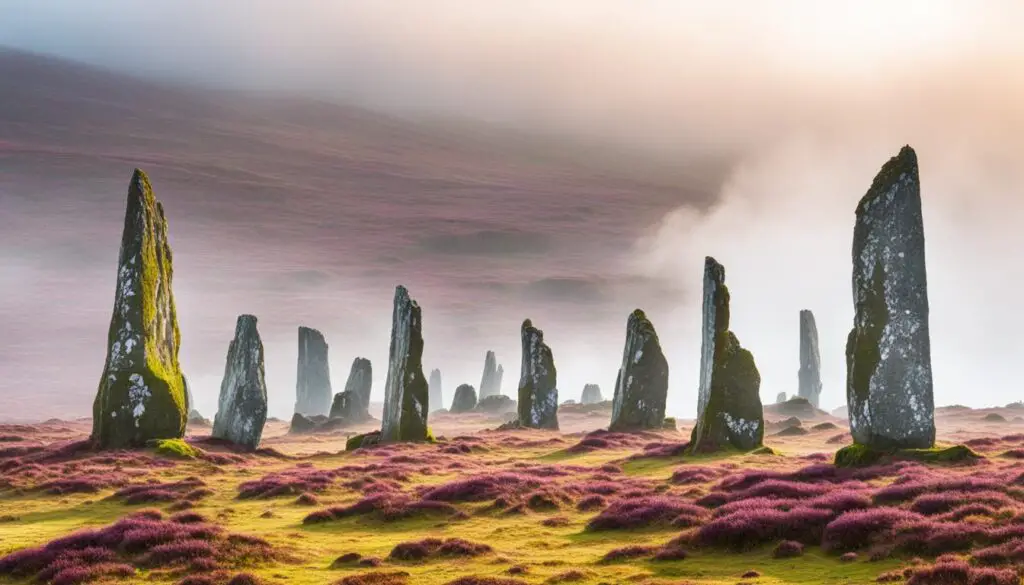
In Celtic Shamanism, sacred sites hold a profound significance. These sites, which include stone circles, burial mounds, and natural landmarks, are believed to have a thin veil between the material and spiritual realms.
This thin veil makes it easier for shamans to communicate with spirits and access the wisdom of the spirit realm.
Shamans often visit these sacred sites to deepen their spiritual practice and receive messages and visions.
The energy and ancient wisdom present in these locations can provide guidance, inspiration, and a deeper connection to the spiritual world.
Benefits of Visiting Sacred Sites
Visiting sacred sites in Celtic Shamanism can bring about transformative experiences and spiritual growth. Here are some of the benefits:
- Enhanced spiritual connection: By immersing oneself in the energy of sacred sites, individuals can strengthen their connection to the divine and align themselves with the spiritual forces of the universe.
- Receiving messages and visions: Sacred sites act as portals to the spirit realm, allowing shamans to receive guidance, insights, and visions from the ancestors and spirit guides.
- Deepening spiritual practice: Regular visits to sacred sites can deepen one’s spiritual practice, helping to unlock hidden potentials, expand consciousness, and foster personal growth.
- Healing and transformation: The powerful energies present at sacred sites can facilitate healing on physical, emotional, and spiritual levels, promoting personal transformation and well-being.
Exploring sacred sites plays a vital role in Celtic Shamanism, as they provide opportunities for direct connection with the spiritual realm and facilitate communication with spirits. These sacred spaces continue to inspire and guide modern practitioners as they tap into ancient wisdom and seek a deeper understanding of the spiritual world.
Rituals and Practices

Celtic shamanic rituals are diverse and multifaceted. They encompass a wide range of practices that connect practitioners to the spiritual realms and facilitate transformative experiences. These rituals play a vital role in Celtic Shamanism, allowing individuals to tap into ancient wisdom and commune with the divine.
Drumming and Chanting
Drumming and chanting are integral components of Celtic shamanic rituals. The rhythmic beats of the drum and the melodic chants create a trance-like state that enables shamans to journey between worlds and connect with spiritual energies. The repetitive nature of drumming and chanting helps induce altered states of consciousness, allowing practitioners to access deeper levels of spiritual insight and wisdom.
Herbalism
Herbalism holds a significant place in Celtic Shamanism. Shamans have long revered the power of plants for their healing and spiritual properties. Herbal medicines and infusions are used to promote physical well-being and facilitate spiritual growth. Plants are seen as allies, providing guidance and support on the shamanic journey. From brewing sacred teas to creating ritual smudge sticks, herbalism is deeply intertwined with Celtic shamanic practices.
Ceremonial Sacrifice
Celtic rituals historically involved ceremonial sacrifices. This practice served as a means to honor and appease deities and spirits. Offerings were made to ensure the blessings of the divine and to maintain harmony in the spiritual realm. While the concept of sacrifice might seem unfamiliar or uncomfortable in modern times, it played a significant role in Celtic Shamanism as a form of devotion and reverence.
Celtic Shamanism and Divination
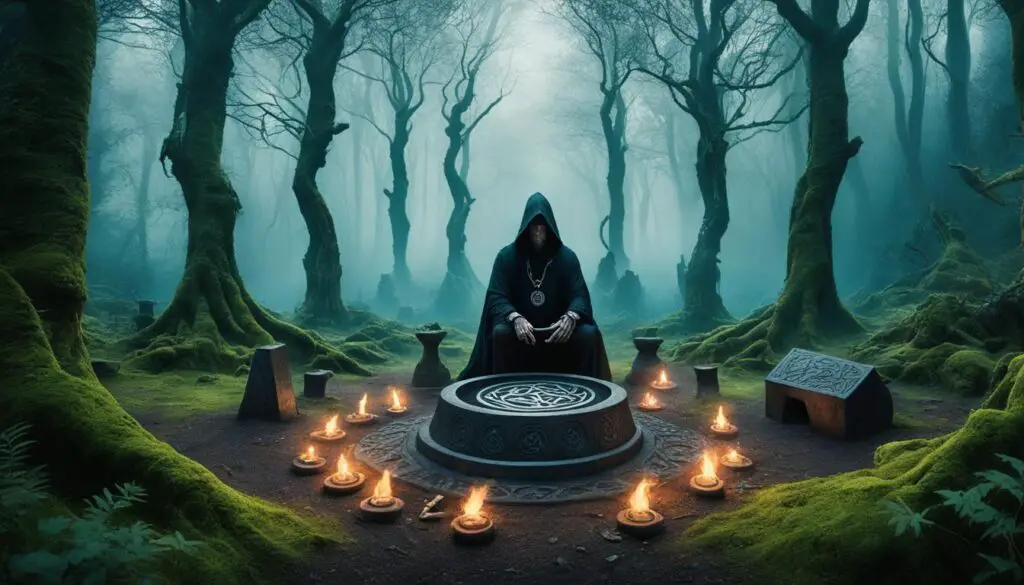
Divination is a fundamental aspect of Celtic Shamanism, providing a powerful connection between the ordinary and the mystical. The Celts employed various divination methods, one of which was Ogham divination. In this ancient practice, symbols representing trees or plants were used to gain insights into the past, present, and future.
Ogham divination involved interpreting the meanings associated with specific trees or plants. By drawing upon the wisdom embodied in nature, practitioners sought guidance and illumination for their spiritual journey. This divination method allowed individuals to explore the hidden realms beyond what is immediately apparent, tapping into the deeper currents of existence.
Animal spirits were also an integral part of Celtic divination. During rituals and trance states, the Celts believed that encounters with specific creatures carried important omens and clues. These animal spirits provided glimpses into the spiritual realm, offering guidance and insight to those who sought divine wisdom.
Moreover, sacred sites held immense significance in Celtic divination practices. The Celts believed that these sites had a thin veil between the material and spiritual realms, making them ideal for communicating with spirits and receiving divinatory messages. By journeying to these sacred locations during trance states, shamans gained access to the wisdom and guidance of the spirit world.
Through divination, Celtic Shamans sought to unravel the mysteries of the universe and discern the hidden forces shaping their lives. By embracing the intricate web of connections between the mundane and the spiritual, they tapped into a wellspring of knowledge and insight that guided their path.
Celtic Shamanism and Astrology

Celtic Shamanism, an ancient spiritual practice rooted in the Celtic culture, shares connections with astrology, although not in the structured zodiac system familiar to many. Instead, Celtic shamans revered lunar wisdom, recognizing the profound influence of lunar cycles on various aspects of life.
In Celtic spirituality, the lunar calendar played a significant role, guiding the Celtic calendar and aligning festivals with key points in the solar year. This deep understanding of seasonal alignment reflected an awareness of celestial influence in daily life and spiritual practices.
Celtic shamans recognized symbolic connections between celestial bodies and aspects of nature. While not directly aligned with zodiac signs, they understood the astrological symbolism and its correlation with the natural world. This recognition allowed shamans to tap into the wisdom and energies associated with celestial events for guidance and spiritual growth.
Lunar Wisdom and Seasonal Alignment
- The lunar cycles were highly regarded by Celtic shamans, influencing agricultural practices, hunting, and spiritual rituals.
- Each phase of the moon held its own significance and was utilized for specific intentions, such as manifestation, releasing, and divination.
- By observing the lunar phases and aligning their actions with nature’s rhythms, Celtic shamans sought greater harmony and connection with the spiritual realm.
Astrological Symbolism in Nature
- Celtic shamans recognized the symbolic connections between celestial bodies and elements of the natural world.
- For example, the rising of certain stars or the alignment of planets might signify the onset of a particular season or the optimal time for specific rituals or activities.
- By attuning themselves to these celestial events, shamans could harness the energies and spiritual insights associated with them.
While Celtic Shamanism and astrology may not follow the same structured system, their interconnectedness reveals a deep respect for the celestial realm and its influence on the earthly realm. By integrating astrological symbolism and lunar wisdom into their spiritual practices, practitioners of Celtic Shamanism enhance their connection to nature and gain access to deeper spiritual insights.
Integration of Astrology and Celtic Shamanic Practices
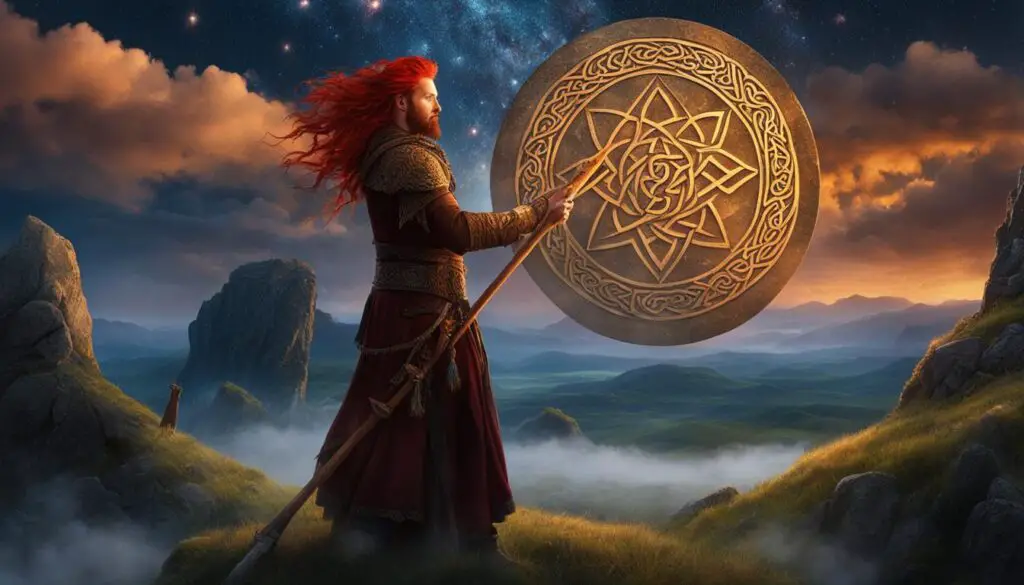
Incorporating astrology into Celtic Shamanism can deepen spiritual practices and provide valuable insights. By combining the wisdom of astrology and the transformative power of Celtic Shamanic practices, individuals can embark on a profound journey of self-discovery and personal growth.
One way to integrate astrology and Celtic Shamanism is through guided meditations. These meditations, often accompanied by drumming techniques, allow individuals to enter altered states of consciousness and venture into the realms of the zodiac. With each meditation, one can explore the unique energies and characteristics associated with each zodiac sign, gaining a deeper understanding of themselves and their spiritual journey.
Spirit animals play a significant role in both astrology and Celtic Shamanism. Each zodiac sign is linked to a specific spirit animal, symbolizing their qualities and strengths. Embracing the spirit animals connected to one’s zodiac sign during shamanic practices can tap into their wisdom and guidance. Whether it’s the courage of the lion for Leo or the adaptability of the chameleon for Gemini, these spirit animals provide valuable insights and support.
To illustrate the integration of astrology and Celtic Shamanism, imagine a guided meditation that takes you on a journey through the zodiac realms. As you enter a deep state of relaxation, the sound of the drum transports you to the celestial plane. With each step, you encounter the spirit animal of your zodiac sign, offering guidance and sharing its unique wisdom.
During the meditation, you may receive messages or symbols that offer insights into your current path and future possibilities. You may also find a deeper connection with your astrological sign, allowing you to harness its qualities and tap into its potential.
By integrating astrology and Celtic Shamanic practices, you can align yourself with the natural rhythms of the cosmos while exploring the ancient wisdom of Celtic spirituality. This integration not only enhances your spiritual journey but also provides a framework for personal growth and transformation.
Spirit Animals and the Zodiac Signs
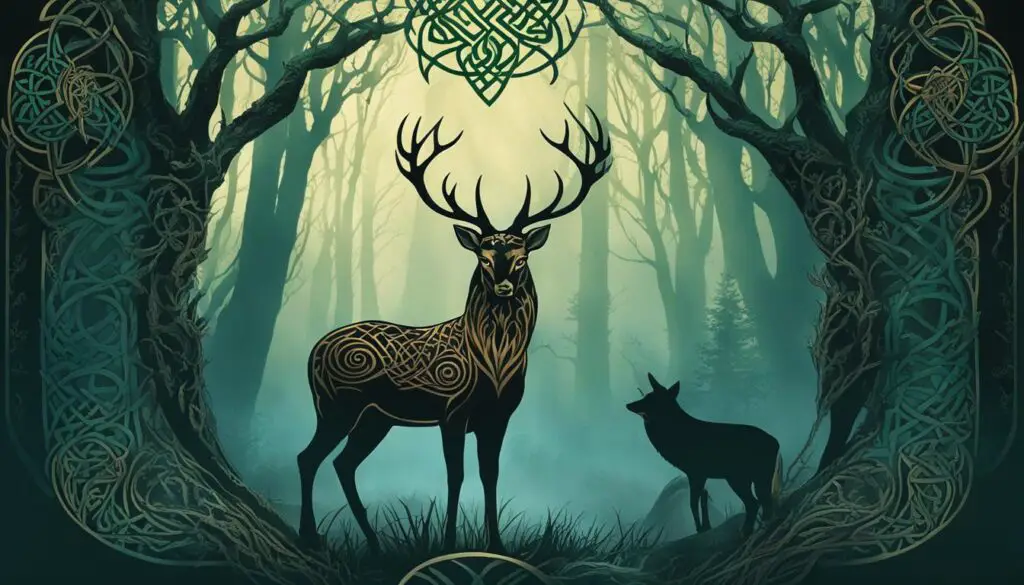
In Celtic Shamanism, each zodiac sign is associated with a specific spirit animal, offering guidance and insights into the qualities associated with the corresponding sign. This connection between spirit animals and zodiac signs enhances individuals’ understanding of themselves and their spiritual journey. Let’s explore some examples:
Aries – The Hawk
The hawk is connected to Aries, symbolizing visionary qualities and independence. Just like the hawk soars high above, Aries individuals possess a natural inclination for leadership, taking charge, and pursuing their goals with determination and focus.
Taurus – The Bull
Taurus is embodied by the bull, representing groundedness and nurturing. With their strong sense of stability and practicality, Taurus individuals have a talent for creating secure environments and offering support to those around them.
Gemini – The Butterfly
Representing the dual nature of Gemini, the butterfly is associated with this zodiac sign. Like the butterfly’s transformative journey, Gemini individuals possess great versatility, adaptability, and a curiosity that leads them on a perpetual quest for knowledge and new experiences.
Each zodiac sign in Celtic Shamanism has its unique spirit animal counterpart, providing valuable guidance and fostering a deeper connection to one’s essence. By embracing the wisdom and qualities of these spirit animals, individuals can navigate their spiritual journey with greater confidence and understanding.
Celtic Shamanism and the Awenyddion of Wales
The Awenyddion of Wales are often regarded as evidence of a native tradition of Celtic Shamanism. Known for their prophecies and oracular utterances, these individuals have captivated the imagination for centuries. In their practice, the Awenyddion would enter deep trances, allowing them to communicate messages from the Otherworld.
While there is ongoing debate about whether the Awenyddion’s practices resemble trance possession rather than traditional shamanism, their ability to commune with the spirit realm aligns with core principles of Celtic Shamanism. Through their prophecies and trance experiences, the Awenyddion tapped into ancient wisdom and offered guidance to their communities.
To better understand the Awenyddion’s role in Celtic Shamanism, it is necessary to explore their fascinating practices and the ways in which they connected with the Otherworld. Journey with us as we delve deeper into the mystical world of the Awenyddion and their profound influence within the realm of Celtic Shamanism.
Conclusion
Celtic Shamanism is a profound spiritual practice that offers deep insights into the spiritual world and the ancient wisdom of Celtic culture. The principles and practices of Celtic Shamanism, including connections to nature, ancestor reverence, Otherworld journeying, and divination, provide a path to understanding and connection with the divine.
By exploring and embracing these ancient traditions, individuals can tap into transformative experiences and deepen their spiritual connections. The belief in the interconnectedness of the material and spiritual realms, along with a strong connection to nature, allows practitioners to align themselves with the rhythms of the natural world and gain spiritual insights and healing.
Honoring ancestors and seeking their guidance and protection is another important aspect of Celtic Shamanism. By invoking their ancestors during rituals, individuals can establish a sense of continuity with the past and tap into the wisdom of their lineage. Additionally, the journey to the Otherworld during trance states or rituals provides access to profound spiritual knowledge, wisdom, and guidance.
From sacred sites that serve as portals between realms to rituals involving drumming, chanting, herbalism, and divination, Celtic Shamanism offers a rich and diverse range of practices. Embracing these practices allows individuals to connect with the ancient wisdom of the Celts and experience profound spiritual growth and transformation.
FAQ
What are the core principles of Celtic Shamanism and how were they practiced?
The core principles of Celtic Shamanism include a strong connection to nature, reverence for ancestors, belief in the Otherworld, and the importance of sacred sites. The practices of Celtic Shamanism involve drumming and chanting, herbalism, divination, and journeying to the Otherworld during trance states or rituals.
How does Celtic Shamanism emphasize a connection to nature?
Celtic Shamanism views nature as a manifestation of the divine, and practitioners believe that by aligning themselves with nature’s rhythms, they can access spiritual insights and healing. Nature is seen as a source of wisdom and guidance, and living in harmony with it is essential to Celtic Shamanic practice.
Why is ancestor reverence important in Celtic Shamanism?
Ancestor reverence is an essential practice in Celtic Shamanism because shamans believe that their ancestors are wise guides who continue to influence the living. By invoking their ancestors during rituals, shamans seek guidance, protection, and a sense of continuity with the past. Connecting with ancestors provides wisdom and insights for the shaman’s spiritual journey.
What is the Otherworld in Celtic Shamanism, and how is it accessed?
The Otherworld is a parallel dimension in Celtic cosmology inhabited by spirits, deities, and mythical beings. Celtic shamans journey to the Otherworld during trance states or rituals to seek wisdom, visions, and guidance. By journeying to this realm, shamans interact with its inhabitants to gain insight and knowledge for themselves and their communities.
What is the significance of sacred sites in Celtic Shamanism?
Sacred sites, such as stone circles, burial mounds, and natural landmarks, hold special significance in Celtic Shamanism. These sites are believed to have a thin veil between the material and spiritual realms, making communication with spirits easier. Shamans visit these sites to connect with the spirit realm, receive messages and visions, and deepen their spiritual practice.
What are some of the rituals and practices in Celtic Shamanism?
Celtic Shamanism involves diverse practices such as drumming and chanting to induce altered states of consciousness, herbalism for healing and spiritual purposes, and divination. Historical accounts suggest that ceremonial sacrifice was also a part of Celtic rituals, with offerings made to appease deities or spirits.
How is divination utilized in Celtic Shamanism?
Divination serves as a bridge between the mundane and the mystical in Celtic Shamanism. Various methods, such as Ogham divination and encounters with animal spirits during rituals, are used for gaining insights into the past, present, and future. Sacred sites and trance states are also utilized for gaining divinatory insights.
How does Celtic Shamanism relate to astrology?
Although Celtic Shamanism does not directly align with the structured zodiac system, it recognizes the symbolic connections between celestial bodies and aspects of nature. Lunar wisdom is highly regarded in Celtic spirituality, and the Celtic calendar and festivals align with key points in the solar year, reflecting an awareness of celestial influence.
How can astrology and Celtic Shamanic practices be integrated?
Integrating astrology and Celtic Shamanic practices involves using guided meditations and drumming techniques to enter altered states of consciousness and journey through the zodiac realms. Embracing spirit animals associated with each zodiac sign also enhances individuals’ understanding of themselves and their spiritual journey.
What spirit animal is associated with each zodiac sign in Celtic Shamanism?
In Celtic Shamanism, each zodiac sign is associated with a specific spirit animal. For example, the hawk is connected to Aries, symbolizing visionary qualities and independence, while the bull represents Taurus and embodies groundedness and nurturing. Each spirit animal offers guidance and insight into the qualities associated with its corresponding zodiac sign.
Are the Awenyddion of Wales evidence of Celtic Shamanism?
The Awenyddion of Wales, known for their prophecies and oracular utterances, are sometimes considered evidence of a native tradition of Celtic Shamanism. While some argue that their practices resemble trance possession rather than shamanism, the Awenyddion’s ability to commune with the spirit realm aligns with core shamanic principles.
What insights does Celtic Shamanism offer through its ancient wisdom traditions?
Celtic Shamanism is an ancient and profound spiritual practice deeply rooted in the cultural heritage of Celtic peoples. Its principles and practices, including connections to nature, ancestor reverence, Otherworld journeying, and divination, offer profound insights into the spiritual world. By exploring and embracing these ancient wisdom traditions, individuals can deepen their spiritual connections and tap into transformative experiences.


